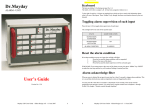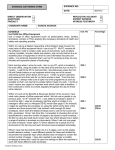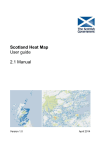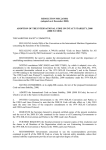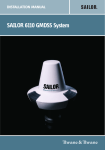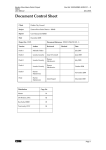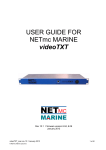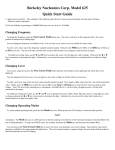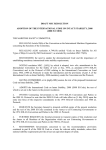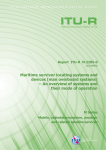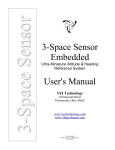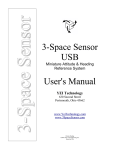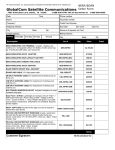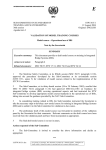Download VHF Handout - DCU Sub
Transcript
Comhairle Fó-Thuinn Student Handouts This Short Range Certificate 1 Course is approved by The Maritime Radio Affairs Unit, Maritime Safety Directorate. © Kate Hills and Irish Underwater Council 2004 Short Range Radio Certificate – Module One (VHF) STUDENT HANDOUT Introduction Introduction VHF Radio This course provides the information and practical knowledge to obtain the Radio Operators Short Range Certificate, Module One. This gives you the Authority to Operate (ATO) Very High Frequency (VHF) radio equipment on any vessel. You will not be qualified to operate Digital Selective Calling (DSC) equipment. VHF radios are used for voice communications with a maximum range of 30 – 40 miles operating in line of sight. The VHF radio is the primary item of GMDSS equipment carried on a dive boat. Most dive boats are now fitted with VHF radios, but there are also portable handheld sets. The fitted sets with an aerial mounted high on the ‘A’ frame tend to be more effective than handheld sets as the VHF radio relies on line of sight for good communications. With the ATO comes the responsibility to follow the radio operating rules laid down by (IMO) from the Safety of Life at Sea (SOLAS) convention and the Irish Maritime Radio Affairs Unit. Course content Section One You must be able to operate Global Maritime Distress and Safety System (GMDSS) equipment and be proficient in the correct voice procedures for radio communications. - Principles and features of VHF radio communications and radio regulations Section Two – VHF Radio Equipment Section Three – GMDSS Equipment Holders of the SRC certificate have the ability to communicate effectively with Coast Radio stations. This increases the safety of people whilst at sea, and any incidents can be dealt with efficiently with the likelihood of a successful outcome. Section Four – Operational procedures for VHF communications Section Five – Regulations Section Six Existing holders of the VHF license may up-grade their license to SRC Module One (VHF) on successful completion of Section 3 and 6 of the course and the practical examination. It is advisable to fully revise all sections in the course. – Practical use of VHF radio equipment and GMDSS equipment Learning outcomes for this course During this course you will acquire the knowledge concerning the type and the safe use of VHF radio equipment. You will learn the methods of communicating in various scenarios in a marine environment and the types of other safety equipment that make up the GMDSS. GMDSS GMDSS uses a combination of equipment to improve distress communications. The system works on a global scale by effectively dividing the world into four regions, A1, A2, A3 and A4 – known as sea areas. The type of GMDSS equipment to be carried onboard vessels is determined by the use and range of the vessel within the sea areas. The skills you will acquire include operating a VHF radio, carrying out equipemnt checks, operating safety equipment. The overall outcome of this course will enable you to effectively communicate any type of happening, general or emergency, and to aid the safety of others whilst at sea. 1 November 2005 Short Range Radio Certificate – Module One (VHF) SECTION 1 STUDENT HANDOUT General principles and features of the VHF radiotelephone communications in the Maritime mobile service Introduction Types of communication This lecture will cover the general features of maritime communication using VHF radios. We will cover the different types of stations that use VHF radio and the types of communications that can be transmitted. We will also cover the regulations governing the use of VHF radios. The types of communications that can be conducted using VHF radio are: 1. Distress, Urgency and Safety – messages of grave and imminent danger, urgent messages and messages concerning the safety of vessels. These messages are broadcast on channel 16, in some circumstances another channel may then be used. Type of radio stations 2. Public Correspondence – communications accepted by the CRS from the public for a vessel at sea. This may be either a phone call relay or a link call. Channels used for this type of communication are decided by the CRS. Ship Stations This is a radio station on board any vessel that is not permanently moored. This vessel can be of any type e.g. cargo, passenger or fishing vessel, yacht or dive boat. 3. Port Operation Service – communication by port authorities strictly for operational handling, movement and safety of vessels in the vicinity of a port. These communications are usually on designated channels (e.g. 10 or 12). Coast Radio Stations (CRS) Coast radio stations are land based, located around the coast to provide communication cover for vessels in the maritime radio frequency bands, VHF and medium frequency (MF). CRS maintain a listening watch for Distress, Urgency and Safety messages. They broadcast Safety messages, e.g. gale warnings, navigation hazards and weather reports at regular times and act as the communication link whilst a vessel is at sea. 4. Intership - communication between vessels at sea on designated channels (6, 8, 68 and 72) 5. Ship Movement Service – a maritime safety service provided in some countries regulating the movement of vessels. 6. On-Board - communications on large vessels usually for mooring and cargo handling operations (usually handheld radios used on low power). Information concerning CRS transmissions can be found in the Admiralty List of Radio Signals (Volume 1) and in some boat Almanacs, e.g. Reeds. Pilot Stations Radio regulations Pilot authorities use VHF radio communications to contact vessels arriving and departing ports to determine pilotage requirements, estimated time of arrival (ETA) and time of departure. If you successfully pass the exams at end of the course, you will be issued with a Short Range Certificate that will give you the authority to operate (ATO) any VHF radio equipment on any vessel within 30 – 40 miles of a Coastal Radio Station Aircraft Stations You then carry the responsibility to abide by the regulations laid down by the Maritime Radio Affairs Unit. Any breach of these regulations can lead to a withdrawal of your ATO. Aircraft, i.e. search planes and helicopters, can use the VHF band to communicate with vessels. (Aircraft can also operate on MF bands as well.) Here is a summary of the radio regulations: Rescue Co-ordination Centre (RCC) 1. Every radio installed on a vessel must be licensed and operated by a qualified operator. The Cox’n is responsible to the licensing authority for the use of the radio and any messages sent. The RCC for Ireland is situated in the headquarters of the Coastguard in Dublin. The RCC co-ordinates any search and rescue operations through the CRS, RNLI and the Coastguard. 2. Radio stations must obey instructions from Coast Radio Stations 2 November 2005 Ship to Coast: 26, 27, 25, 24, 23, 28, 04, 01, 03, 02, 05, 07, 84, 87, 86, 83, and 85 3. Stations must identify themselves when transmitting by using either their name or call sign Ship to Port: 12, 14, 11, 13, 09, 68, and 71 4. Before transmitting a message a station must listen to ensure no interference with communications already in progress Ship to Ship: 06, 08 (More commonly used channels listed first) Digital Selective Calling: channel 70 is used exclusively for digital selective calling for distress, urgency and safety. Radiotelephone operations are forbidden on channel 70. 5. Channel 16 (156.8MHz) is the international distress frequency for VHF. This channel is used for distress, urgency and safety communications as well as routine calls and replies prior to changing to an agreed working channel 10. It is forbidden to use the VHF radio for unnecessary signals or to communicate with stations other than Coast Radio Stations or ships. The transmission of messages to shore unless through a CRS is strictly forbidden. 6. All transmissions on Channel 16 should be kept to a minimum 7. For the Safety of Life at Sea (SOLAS) all stations fitted with VHF radios should keep a continuous listening watch on the distress frequency – Channel 16 11. It is forbidden to repeat anything heard on the air. When you sign the application form for radio licence you also sign the Secrets Act. A breach of the Secrets Act can result in loss of your licence to operate a radio or a jail sentence 8. Listening watch may only be discontinued when: The radio is used for traffic on another channel The radio is maintaining watch on another channel for the purposes of port operations, ship movement or the safety of navigation Test Transmissions All test transmissions must be kept to a minimum, no more than 10 seconds. The listening watch on the distress channel is maintained elsewhere on the vessel You must transmit your identity including your name, call sign and Mobile Maritime Service Identity – this is a code that is part of the radio equipment. The maintenance of the watch is detrimental to the safety of the vessel as determined by the cox’n 9. For the VHF marine band (156 to 174 MHz) ship stations must be able to send and receive on: Call Signs When a radio installation is registered the vessel is issued with a call sign. This is a unique number (prefixed with EI in Ireland) and is used in conjuntion with the name of the vessel for identification. The call sign is specific to the vessel and the owner of the vessel. (i) The distress channel – 16 (ii) The primary inter-ship channel – 6 (iii) Frequencies necessary for the vessel’s service – Some VHF Channels to Remember Ch 16 – Distress, Urgency, Safety and Calling (simplex) Ch 6 & 8 – Inter-ship Channels (simplex) Ch 12 & 14 – Ship to Shore Pilots and Ports Ch 13, 15 & 17 – Low power only for onboard communications (simplex) Ch 23, 24, 67 & 01 – Ship to CRS (Duplex) Ch 25, 26 – For link calls Ch 70 – DSC ONLY All Coastal Radio Station VHF working channels are in the 20’s 60’s and 80’s e.g. Malin Coast Guard 23, Dublin Coast Guard 83 Aircraft communications can be carried out on channel 6 3 November 2005 Coast Radio Stations 4 November 2005 Short Range Radio Certificate – Module One (VHF) SECTION 2 STUDENT HANDOUT VHF Radio Equipment The Up and Down switch is used for selecting channels – sometimes there may be a Rotary channel switch for selecting channels quickly The VHF Radio The VHF radio is used for voice communications in Sea area A1 – described in Section 3: GMDSS. A VHF radio usually operates on two power settings with a range of up to 30 to 40 miles on high power (25W) but needs to be within line of sight. On low power (1W) a VHF radio will operate for approximately 0.5 to 1 mile. The range of transmission will also depend upon the height of the aerial. The mode of transmission describes what type of signal a radio transmits. A VHF Radio uses F3E/G3E as the mode of transmission, this is unofficially known as FM. Dim function to increase/decrease the light on the display and key panel. The VHF radio will always be backlit when initially switched on. Push To Talk (PTT) button is located on the handset and is used when transmitting to open the channel. A led marked with the letters Tx will appear on the display of the radio when transmitting. Rx in the display denotes the radio is in receiving mode – i.e. the other radio station is transmitting and your radio is receiving. Features of A VHF Radio: The radio will usually have a memory to store channels, denoted by MEM appearing in the display for each channel stored in the memory. The power output of a VHF radio is 25 watts on high power (HI) and 1 watt on low power (LO). Low power should be used as much as possible to avoid interfering with other transmissions in progress. There is also a CH 16 button, which will recall channel 16 instantly from any other channel. The frequency range is VHF marine band between 156 MHz to 174 MHz. SCAN function will scan all channels entered into the memory; PSCAN will scan channels in the memory and channel 16. The voltage supply required is 13v DC, supplied by batteries The squelch control will mute the loud speaker when random noise activates reception in the absence of a defined signal. The squelch should be set at the threshold where the noise/hiss just stops. Any higher and weak signals may be lost. A ‘D’ in the display denoting a Duplex channel shows the mode of transmission. Hand held radios have the same features and function keys as fixed radios. It is a good idea to familiarise yourself with the instructions as some VHF radios, both fixed and hand held can have extra features. Dual watch function will enable a listening watch on Channel 16 and one other channel to be maintained simultaneously. 5 November 2005 Mode of Transmission VHF Antennas The VHF radio can be used in two different modes to talk to other stations – simplex or duplex. VHF communications is effective in the range of line of sight; the main factor that governs this range is the height of the antenna above sea level. Vessels with high masts will generally transmit and receive over a greater distance than a small rigid inflatable boat. The ‘line of sight’ is a good guideline for the range of a VHF radio. In simplex mode the same frequency or channel is used to transmit and receive messages, so only one station can talk at a time. The word OVER must be used to indicate that the message is sent and a reply is now required. By transmitting when the other station is transmitting will cut off their transmission, so neither station will hear. The VHF antennas are constructed of various materials ranging from a thin metal wire to a dipole aerial which is a very small wire coated with a hard plastic coating. A coaxial cable runs from the base of the antenna to the back of the VHF radio. These connections should be checked and tightened regularly. The cable and connections must be checked for signs of corrosion. If the VHF radio is located inside a casing or wheelhouse the cable must be checked where it enters the bulkhead as wear may occur here. Any corrosion of the coaxial cable can lead to a VHF radio not receiving or transmitting optimally. Tx & Rx 156.8 MHz Simplex mode Duplex communication uses two different frequencies or channels for transmission and reception and therefore can transmit and receive at the same time. A spare antenna should be carried in case of emergency, and should be kept in a safe location correctly labelled. (The spare antenna cannot be stored mounted in place.) On vessels that have multiple antennas aloft, a sketch should be available to clearly identity which antenna is connected to each piece of equipment in the wheelhouse. 157.375 MHz Sources of Energy 161.975 MHz SOLAS regulations and the Torremolinos Convention state that vessels must carry a reserve source of energy in the event of a loss of main power to enable it to conduct distress and safety communications. Duplex mode A reserve generator or a set of emergency batteries can provide the reserve power. In duplex mode the handset can be used just like a normal telephone – just keep the PTT button pushed and talk. If batteries are the sole means of providing reserve power they must have enough reserve energy to supply the equipment for six hours. Duplex communications work best if the transmitting and receiving aerials are placed as far as possible away from one another and also if the highest possible frequency separation is used. If a reserve generator is fitted this must come on-line automatically and be fully operational in 45 seconds. Line of Sight 6 November 2005 will last for 10 hours. Batteries connected in series will have the same Ah as each individual battery, whereas the voltages are added together. Two 6v batteries with 50 Ah in series will deliver 12v but have a capacity of 50Ah. (Emergency batteries are still required in this case but they only need to support one hour of communications). Radios usually run on an AC mains supply transformed down to 24v DC with the batteries as the reserve source of energy. The batteries are on a ‘float charge system’ so if the mains fail the batteries automatically cut in. Cells connected in parallel will give an increased Ah capacity but the voltage will remain as each individual battery. Two 6v batteries with 50 Ah in parallel will deliver 6v but will have a capacity of 100Ah. Radio batteries must be installed in the upper part of the vessel, and there must be a visual and/or audible alarm to indicate the failure of the system. There should be a battery meter to indicate the battery voltage and charging current. Most vessels use 12 or 24 volts for their battery bank but in older vessels 110 volts is not uncommon. Lead acid cells consist of a series of lead plates immersed in a liquid called the electrolyte. The electrolyte in these batteries is sulphuric acid. Sulphuric acid is very corrosive so care must be taken when handling it, using protective gloves and safety glasses. Primary batteries are non-rechargeable, they will have an expiration date and at that date, or if used, they must be replaced with new batteries. Secondary batteries are rechargeable. After use, or after prolonged storage, these batteries must be recharged to restore their capacity. Lead acid batteries are popular because they are cheap and can supply high current when needed. One disadvantage is that they give off hydrogen when being charged and this is a very explosive gas. Most batteries are made from a series of individual cells. Every battery, and indeed every cell making up a battery, has a positive (marked +) and a negative (marked -) terminal and each cell has a nominal voltage. Any battery compartment must be well ventilated and care must be taken not to cause a spark near a charging battery and, of course, nobody working in or near the battery compartment should smoke. Lead Acid Batteries The lead acid battery is the most common type of large rechargeable battery. This is the same as the ubiquitous car battery. Each battery is made from a number of individual cells, each having a nominal voltage of 2 volts. Regulations stipulate that the voltage of any secondary batteries should be read and recorded each day and in the case of lead acid batteries, the specific gravity of the electrolyte should be measured and recorded each month. An instrument known as a Hydrometer is used to measure the specific gravity of the batteries. Most batteries are made with 3 or 6 cells giving a battery voltage of 6 or 12 volts. These batteries are then grouped together to make a bank of the required voltage and capacity. When cells are connected in series their output is equal to the sum of their voltages. For example three 2volt cells connected in series will have an output of 6 volts. The capacity of a battery in a standard discharge period is measured in amperes hour (Ah). A battery with a capacity of 200Ah powering a radio consuming 20amps CONDITION DENSITY (S. G.) CAPACITY Fully charged 1.28 100% Nearly fully charged 1.25 75% Half charged 1.225 50% Nearly discharged 1.19 25% Terminal Vent Intercell Connections Plates Separator Case Hydrometer 7 November 2005 • Deposits on terminals can be removed with baking soda and water solution Ni-cad batteries Ni-cad batteries are dry cell batteries; they are used in some radio equipment such as handheld VHF radios. Some of the older types have a ‘memory’ effect so must be discharged fully prior to recharging or they will deliver a reduced Ah capacity when next used. Ni-cad batteries are tested using a voltmeter to check the battery level. Precautions to be taken when working with batteries • No naked lights near battery installation • Do not recharge at too high a rate • Remove any watches and rings Battery Maintenance and Care • Be careful using any spanners or tools (risk of shorting out) • All batteries must be fully charged on installation • Never leave batteries discharged for long periods • Check battery voltage daily ON LOAD (a 24 volt battery should be no less than 23 volts) • Keep electrolyte level above plates • Top up electrolyte with distilled water • Fully charged 12 volt battery should have 12.7 to12.9 volts when checked with voltmeter • Keep the tops of batteries clean and dry • Keep terminals tight • Cover terminals - with petroleum jelly • Do not use battery lockers as storage spaces; in heavy weather 'things ' may fall across the terminals, with the risk of FIRE • Keep area well ventilated when recharging due to the release of hydrogen gas • Keep gloves and safety glasses in battery box • Avoid over-discharging a 24 v battery not below 21v; a 12 volt battery not below 10.5 volts) • Always disconnect earth lead first and reconnect it last 8 November 2005 Short Range Radio Certificate – Module One (VHF) STUDENT HANDOUT SECTION 3 Global Maritime Distress and Safety System: GMDSS Introduction The primary function of GMDSS is to, using a combination of different equipment, improve distress communications between radio stations: shore to ship, ship to shore and ship to ship. The aim of GMDSS is to directly alert a Shore station of a vessel’s need for assistance, whereas the older system aimed to alert other vessels in the immediate area. The Inmarsat system There are 6 further functions providing: 1. Definitions of the Sea Areas: Search and Rescue (SAR) information – using digital selective calling to relay information Area A1 – within VHF range of a coast radio station (approximately 30 – 40 miles) This is the area that the Short Range Certificate for VHF is valid 2. On-scene communications – using VHF radios 3. Emergency locating – using EPIRB’s and SART’s 4. Marine safety information (MSI) – providing navigational and weather warnings 5. Routine information – providing messages Area A3 – within coverage of an INMARSAT – the satellite communications system 6. Bridge to bridge communications – providing ship to ship communications Area A4 – outside INMARSAT coverage north of 70°N or south of 70°S Area A2 – within medium frequency (MF) range of a CRS (approximately 150 miles) How does the GMDSS work? The GMDSS accomplishes its functions: 1. By dividing the world into Sea areas 2. By the equipment carried onboard vessels GMDSS Sea Areas The sea is divided into four Sea Areas: A1; A2; A3 and A4, the specific area is defined by the distance from a Coast Radio Station (CRS) together with coverage by the ‘INMARSAT’ satellite communications system. INMARSAT is a satellite system that supports distress alerting and communications through voice, telex, data such as fax and e-mail and even video conferencing. The system works by the communications being sent via a number of geo-stationary satellites. INMARSAT has no satellites in the polar regions therefore communications cannot be picked up in areas north of 70°N or south of 70°S. (A geo-stationary orbit is a satellite in an orbit travelling at the same speed as the earth – if you were to stand in one spot under one of these satellites and look up, it would appear not to be moving as it is travelling at the same speed as you are on the earth!) Equipment Required to Comply with GMDSS The equipment required under GMDSS Rules varies depending on the size of vessel and its Sea Area of operation. The different types of equipment is necessary in order for the vessel to effectively communicate with a shore station – the primary aim of the GMDSS. 9 November 2005 For Example: Emergency Position Indicating Radio Beacon – EPIRB A craft working within Sea Area A1 may only require a "D" Class VHF, EPRIB and SART. There is no requirement for Digital Selective Calling equipment for pleasure craft yet. The EPIRB is used for distress alerting, and will be activated automatically if a vessel does not have time to send a distress alert by any other means. It is a float free beacon, it will float away from the vessel should it sink/capsize. A vessel working in Rockall or further away from home in sea areas A2 and A3 would require VHF, VHF DSC, MF/HF and DSC, also satellite communication equipment such as INMARSAT A/B or C. Further functions of GMDSS 1. Search and Rescue Information Digital Selective Calling (DSC) is the backbone of the GMDSS and one of the most important systems. The DSC unit transmits and receives calls and basic messages in the form of digital code and works in a similar manner as a mobile phone. Each DSC station has its own unique number called a Maritime Mobile Service Identity (MMSI) number. The MMSI is a unique 9-digit code, which is permanently stored in the DSC equipment and this code is automatically included in each call. This removes any requirement for a skilled operator to make a distress or safety call. A DSC unit can also operate in conditions where there is high noise interference and poor signal strength. The Maritime Identification Digits (MID) are internationally allocated and makes up part of the MMSI The Irish MID is 250. The position of the MID in the MMSI depends on the type of station: Ship Stations 250****** Groups of Ships 0250***** Search and Rescue Radar Transponder – SART The SART is used for emergency locating by using Radar; it is taken with the crew when abandoning ship. Once activated and trigged by a radar signal, a SART will leave a trace on that radar indicating a bearing and range to its location. These two beacons, EPIRB’s and SART’s are a very important part of the GMDSS in that they provide the mariner with a secondary alerting and location system (VHF radio or DSC being the primary method) in the event of sinking or abandoning ship without transmitting a distress call or alert. We will look at the two types of beacons in more detail later. Personal Location Beacons – PLBs These beacons are for personal use. It is becoming more common that a diver carries a personal location beacon in the event of separation from the dive boat. A single diver with no signalling device can be hard to locate. A PLB works in exactly the same manner as an EPIRB. Emergency Location Transmitters – ELTs An ELT is used in aviation. 4. Marine Safety Information – MSI Coast Station 00250**** (Coast Stations around the world will always be identified by the ‘00’ prefix) The primary use of the DSC unit is for distress alerting and allows for two types of distress alert to be transmitted. a) Designated – where information such as time, position, nature of distress and type of communication is sent b) Undesignated – which contains only basic information such as MMSI, position and time. DSC has also many other functions such as urgency and safety alerting. 2. On Scene Communications This is the operation of a VHF radio and the regulations governing its use. This is described fully in Section 4. 3. Emergency Locating The GMDSS uses the following equipment to locate vessels in distress: 10 Navtex – this is a navigation telex is used to receive Marine Safety Information from stations around the coastlines of various countries. This information can include weather forecasts, gale warnings and navigation warnings. VHF – information is relayed via channel 16 from local CRS to vessels in the area, covering weather forecasts, navigation warning and gale warnings 5. Routine Information All the methods of communication also facilitate routine information to be transmitted. This would include traffic lists, messages from shore, traffic routes or port information. 6. Bridge-to-Bridge communications On larger vessels it may be necessary for the crew to communicate via VHF on low power for navigational purposes. November 2005 Each beacon is programmed with the ID of the vessel it is registered to, so they are not inter-changeable. The EPIRB’s are usually programmed with the MID number of their country and the vessels call sign. Emergency Location Beacons The Satellite Systems Two satellite systems are used to detect emergency locating equipment: For example an Irish diving boat may have an EPIRB programmed with: a) INMARSAT – as described before this satellite system supports distress alerting as well as communications through voice, telex, data such as fax and e-mail and video conferencing. 250 (Irelands MID number) EI3684 (vessels Callsign) 250EI3684 The EPIRB is released automatically by a hydrostatic release unit (HRU), which activates when immersed in water to a dept of 1.5 to 4 meters – as when a vessel begins to sink. The EPIRB will float up to the surface and start transmitting. All EPIRB’s can also be activated manually. b) COSPAS-SARSAT system – a network of satellites controlled by 5 countries (USA, Russia, France, Canada and India) party to the COSPAS-SARSAT agreement set up to detect distress alerts from emergency locating beacons. The concept of the system is that satellites scan the surface of the earth listening for distress signals from beacons and once detected the satellite then relays the distress alert back to earth so a search and rescue mission can begin. Once transmitting the 406/121.5 MHz EPIRB will be detected by one of the eight polar LEO satellites. The beacon will be transmitting the ID of the vessel in distress but not the position. The satellites calculate the position of the beacon by using Doppler processing. As the satellite is moving and the beacon is stationary, the satellite senses if the strength of the signal as it flies by, transmitting this information to the LUT. The apparent change of frequency enables the satellite together with the LUT to calculate the position of the EPIRB. For a beacon transmitting on 406 MHz this accuracy is approximately plus or minus three miles. The COSPAS-SARSAT system consists of a space segment and a ground segment. The space segment is made up of eleven satellites, of which eight are in low earth orbit (LEO) of between 830 and 1000 km altitude. These LEO satellites are in polar orbit, which means that the satellites fly in a north-south direction across the sky. It takes about 100 minutes for one satellite to complete one orbit of the earth. Therefore, because the earth is rotating beneath the satellite, every 12 hours one satellite will have covered every location on the earth. With the eight satellites in polar LEO the detection time for a distress signal from a beacon can be as little as 30 minutes in mid latitudes. Most new EPIRB’s will transmit on both 406 MHz and 121.5 MHz. EPIRB’s that transmit on 121.5 MHz only are very limited in their capability compared to those that transmit on 406 MHz. The problem with transmitting on 121.5 MHz only is that the orbiting satellite must have both the beacon and LUT in view at the same time; otherwise the satellite will disregard the signal from the beacon. A satellite can remember the information received from an EPIRB transmitting on 406 MHz and the relay this information to the next LUT it flies by. The other three COSPAS-SARSAT satellites are in geostationary orbit 35,000 km above the equator and do not move relative to the earth (in the same manner as the INMARSAT satellites). The ground segment consists of 32 Local User Terminals (LUTs). These are the stations that receive information from the satellites and inform the MRCC’s that a beacon has been activated. As the geo-stationary satellites do not move across the sky (as the polar LEO satellites), they cannot carry out Doppler processing to calculate the position of the beacons. The only way these satellites find the position of an EPIRB is with GPS. New EPIRB’s are now fitted with GPS systems so a more accurate position can be transmitted to the geo-stationary satellites. This will improve positioning accuracy to about 100m. Only the 406 MHz EPIRB’s have this feature. The Equipment EPIRB’s and SART’s are important in the GMDSS as location beacons. The EPIRB is used to alert the rescue services to a distress (giving an idea of the location), whereas the SART is used to ‘home in’ the distressed vessel. EPIRB – using the COSPAS-SARSAT system The COSPAS-SARSAT countries have announced that the 121.5 and 243 MHz frequencies will be discontinued in 2009. An EPIRB can transmit on the following 121.5 MHz 406 MHz and 243 MHz. Most EPIRB’s fitted to Irish fishing vessels transmit on 406 MHz and 121.5 MHz. The following Table shows the differences between the 121.5 and 406 MHz beacons. 11 November 2005 Transmitting frequency Polar Low Earth Orbit Satellite 406 MHz Beacon ID available Location information (+/- 3 miles accuracy) Global Coverage 121.5 MHz No Beacon ID available Location Information (+/-12 miles accuracy) Local mode coverage only (may result in delays in detection) This frequency can be used to home into the vessel in distress by surface craft and aircraft. EPIRB – using the INMARSAT system SART INMARSAT EPIRB’s transmit on 1.6 GHz and require a feed from a navigator such as GPS. The INMARSAT system does not have any polar orbiting satellites so beacons cannot be detected in sea area A4 - north of 70°N or south of 70°S. A life raft is a very small target for a ship’s radar to pick up especially in a heavy swell or poor visibility. With the use of a SART a series of signals are transmitted to the search vessel’s radar to help locate the survival craft. The signals will only be detected using X band or 3cm radar. S band or 10cm radar will not detect these signals from a SART. The SART and X band radar transmit and receive on about 9 GHz. EPIRB Standards The EPIRB must be tested every month and the test logged in the GMDSS logbook (described later). The EPIRB handbook should be read to ensure the test procedure is carried out correctly. The battery in the EPIRB must be replaced every 4 years (the expiry date will be marked on the EPIRB). The hydrostatic release unit must be replaced every 2 years. Once active the EPIRB must have the power to transmit for at least 48 hours. The test procedure will be described and practiced during the practical session of this course. EPIRB Summary Transmit frequency 121.5 MHz / 406 MHz (INMARSAT 1.6GHz) Release mechanism Hydrostatic Release Unit (renew every 2 years) Transmit Information MID + Callsign (250EI1234) Transmit time At least 48 hours Battery Replace every 4 years Test Every month and log it GPS INMARSAT and new on COSPAS-SARSAT system MODE The SART should be located in the wheelhouse or by the ship’s lifeboats and depending on the size of the vessel two SART’s may be required. In a distress situation the SART should be taken into the life raft. Once in the life raft the SART should be activated and placed about 1 metre above sea level. Some SARTs have telescopic poles; others will need to be tied in place. Once the SART is activated it ‘listens’ for a radar signal. The SART will ‘listen’ for 96 hours. The SART is a transponder operating only when it detects a radar pulse; once detected it will begin transmitting a series of pulses back to that radar. The battery will last for 8 hours once the SART is activated. It is important to turn off the vessel’s own radar before leaving to avoid the SART responding to the radar of the sinking vessel, especially if it remains afloat for a period of time. The pulses transmitted by the SART show on the radar as a row of twelve dots, indicating the range and bearing of the survival craft. As the search vessels close in on the SART, the dots will turn into arcs and then, when the SART is very close, to circles. The range of detection will depend on the height of the SART and the height of the radar scanner of the search vessel; this can be up to 5 nautical miles. An aircraft flying at 1000m may detect a SART from 40 nautical miles. 121.5 MHz Local positioning 406 MHz Global positioning 12 November 2005 Once the SART responds it will continue to transmit pulses for 8 hours, after that the battery may fail. a radar signal periodically – this will be dependant upon the manufacturer. If the life raft has a radar reflector it is important it is not used with the SART, as large shadow sectors will be seen on a searching vessel’s radar; this may result in the SART not being detected. The test procedure will be described and practiced in the practical session at the end of the course. A vessel searching for a SART may detune the radar so land and other targets do not show. It is also useful to turn off filters for sea and rain interference. The radar operator will adjust the reading of the radar for optimum to detect a SART. However the search vessel should not become a hazard to navigation, so this may only be done if a second radar is available for navigation purposes. In the case of accidental activation leave the SART on and contact the CRS using a PAN PAN call. Give the details of the event and tell the CRS the SART is being switched off. SART Standards The SART must be tested every month and the results logged in the GMDSS Logbook. The SART manual should be referred to ensure the correct test procedure is carried out. The SART battery should be replaced every 4 years. It is recommended that the SART be tested with 13 SART Summary Turn own radar OFF before abandoning ship Once activated SART will listen for 96 hours Once triggered by a radar signal SART will TX for 8 Hours SART transmits on 9 GHz Do not use a radar reflector along with SART SART will show 12 dots on RADAR, becoming arcs, then circles as range decreases. When searching for a SART only detune radar if you have another to use for navigation and collision avoidance. SART must be tested every month Battery replaced every 4 years Service the SART every 4 years. November 2005 Short Range Radio Certificate – Module One (VHF) SECTION 4 STUDENT HANDOUT Operational Procedures and Regulations for Radiotelephony Communications Introduction There are procedures and protocols for using VHF radios that enable a qualified person to effectively communicate with any radio station in any position in the world. During an emergency the transmission of information can be vital to the successful outcome of an incident. The protocol for communications follows a set pattern and there are regulations governing the use of VHF. When communicating with radios there are certain terms and a phonetic alphabet used that are universally recognised. The use of a VHF radio should be practiced until it becomes second nature – this will be important during a distress call, where time may be short. VHF radios can provide important information for the navigation of vessels, e.g. navigational hazards; weather. Also by contacting the CRS prior to leaving port with route details you are ensuring a rapid response if an emergency arises. Radio communications fit into four main categories: 1. Distress 2. Urgency 3. Safety 4. General Working channel to be used Channel 24 OVER Over The reply from the station called would be as follows; Call sign of calling ship EI 2308 Name of calling ship (x 3) Diver 1, Diver 1, Diver 1, THIS IS This is Name of station called (x 3) Malin Head, Malin Head, Malin Head, Working channel Channel 24 OVER Over The calling station suggests a working channel for further transmissions. The station called must agree the working channel before switching channels. A CRS will determine the working channel, whereas between ship stations the called station will set the working channel. Procedure for making VHF call The method of making and responding to VHF transmissions follows a set pattern. Initial transmissions are made on channel 16 – the distress channel – all radio stations will be listening to this channel. Once initial contact is made the calling parties can agree a working channel for further communications. It is important that the message can be understood by the intended recipient and also that the sender can be identified. A voice transmission would take place as follows: If you expect a reply you should use the word ‘OVER’ at the end of your message. The word ‘OUT’ indicates no reply is expected. This is the basic procedure for contacting another radio station. Most CRS will receive calls direct on their working channels without the need to clog up channel 16. Communications between vessels can be made directly on inter-ship channels. Name of ship/CRS called (x 3) Malin Head, Malin Head, Malin Head, If the conditions are good for making contact the calling ship need only repeat the call sign twice after ‘THIS IS’ instead of the name x 3. THIS IS This is Once contact is made the radio stations need only use either names or call signs. Call sign of calling ship EI 2308 If the station called does not reply the call may be repeated at three-minute intervals, but the calling station must ensure there is no other communication in progress. Name of calling ship (x 3) Diver 1, Diver 1, Diver1 A silence period should be observed on Channel 16 on each hour and half hour for three minutes. Any routine communications should not be carried out during these periods. Reason for call Group of 8 divers leaving port for dive 14 November 2005 Message - Mayday, Phonetic Alphabet and Numerals This is (name), (call sign) At times the transmissions can be difficult to hear, the exact word a caller is trying to say may be the very item of information required in an emergency. A phonetic alphabet and numerals have been developed with this in mind. Each letter of the alphabet is allotted a word. If part of a transmission is not clear the message can be spelt out using the allotted words below for each letter, the word prefixed by the caller saying ‘I spell’. J – juliett K – kilo L – lima M– mike N – november O – oscar P – papa Q – quebec R – romeo A – alpha B – bravo C – charlie D – delta E – echo F – foxtrot G – golf H – hotel I – india My position is: (position of vessel – if no GPS, best estimate) Problem: (e. g. sinking) Other info: (number of people, conditions, etc.) OVER. The more information transmitted in the distress message about the situation the better, but if time does not permit the most vital information to transmit are the position and the identification of the vessel in distress. S – sierra T – tango U – uniform V – victor W– whiskey X – x-ray Y – yankee Z – zulu If no reply is received the distress message and call can be repeated on any channel where attention maybe received. On hearing a distress signal all stations must cease any transmissions that may interfere with the distress communications. If you hear a distress call which is not followed by a message you should listen for at least 3 minutes and then inform the nearest CRS. For example: DIVER would be: If you hear a distress call on the radio try and write down the message, position of vessel and ID. You can then plot the position relative to you and determine bearing and distance to the vessel in distress. I spell Delta, Indigo, Victor, Echo, Romeo The numerals are pronounced as follows: 0 – zero 1 – wun 2 – too 3 – three 4 – fo-wer 5 – fife 6 – six 7 – seven 8 – ait 9 – niner If you are in a position to render assistance do not acknowledge the distress call straight away, particularly in sea area A1 as the nearest CRS will normally acknowledge the call immediately. You should then acknowledge the distress call in the following manner. Vessel in distress – Scuba 1 Vessel acknowledging the distress call – Deep Blue Distress Communications Acknowledgement A distress signal must only be used when a vessel (ship, aircraft or other vehicle) is in grave and imminent danger and requires immediate assistance, for example: sinking or on fire. - Mayday, Scuba 1, Scuba 1, Scuba 1 This is Deep Blue, Deep Blue, Deep Blue, The distress signal is Mayday Received mayday. The distress signal is transmitted in two parts (i) Once all vessels in the area have acknowledged the distress call, then you can call back the distressed vessel and inform them of your ETA and any other relevant information. During distress communications the word Mayday should precede all messages. the call to get attention (ii) the message providing information such as position and nature of problem The complete distress call and message is transmitted on channel 16. The Mayday signal is a broadcast, and is not addressed to anyone in particular. All responses and further transmissions remain on channel 16 until the distress has been resolved. Call Back - Mayday Scuba 1, Scuba 1, Scuba 1 This is Deep Blue, Deep Blue, Deep Blue, I am 4 miles to the north of you, Here is an example of a distress call and message- My ETA to you is 20 minutes. Call We have pumps onboard and may be able to assist. Over. - Mayday, Mayday, Mayday, This is (name), (name), (name) 15 November 2005 Distress relay During a Distress A distress relay is sent in a situation where the vessel in distress is unable to send a distress call itself, and another vessel sends the call on their behalf. A distress situation is handled by the CRS and the following may be requested: The CRS can also transmit a call of this nature to inform all ships that a vessel requires immediate assistance. The signal for a distress relay is Mayday Relay. Vessel in distress – Scuba 1 b) CSS – Co-ordinator of surface search – appointed by the OSC The first vessel on scene is normally appointed OSC. The responsibilities of this vessel include: - Vessel relaying distress signal – Red Light Relay Call a) OSC – On Scene Commander – appointed by the MRCC or CRS (i) Keeping CRS/MRCC informed of situation Mayday Relay, Mayday Relay, Mayday Relay (ii) Searching the area and organising other vessels in the search (appoint CSS), This is Red Light, Red Light, Red Light (iii) Co-ordinating on scene communications Relay message Mayday (iv) Recovery of survivors Scuba 1, Scuba 1, Scuba 1 Ship to aircraft frequencies that may be used are Ch 16 or Ch 06. In Position 55º 37`N 08º 55`W On fire, requires immediate assistance, If a distress is in progress you may be able to contact a CRS on a different frequency. Over. Imposing Silence Cancelling Distress During search and rescue (SAR) operations a CRS may impose silence on the distress Channel or frequency by using the phrase ‘Seelonce Mayday’. When imposing silence the call should be to ‘All stations’ and the word Mayday used at the start of the call. The phase ‘Seelonce Prudonce’ is used to notify all stations that limited communication is allowed on the distress channel or frequency, but the distress situation has not been completely resolved. Again the word Mayday precedes the message. Example: Mayday Example: Mayday All stations, All stations, All stations All stations, All stations, All stations This is Malin Head CG, Malin Head CG, Malin Head CG, This is Malin Head CG, Malin Head CG, Malin Head CG, Seelonce Mayday Seelonce Prudonce Seelonce Mayday Seelonce Prudonce By imposing silence the CRS is telling all vessels not involved in the SAR operation to keep the distress channel or frequency being used clear so there will be no interference to distress transmissions. When an SAR operation has ended the CRS will transmit the signal ‘Seelonce Fenee’. This informs all stations that normal working can now resume. During distress communications a vessel can impose silence by using the phrase ‘Seelonce Distress’. This is usually done when a station is heard transmitting information that has nothing to do with the present distress situation on the distress channel. Example: Mayday All stations, All stations, All stations This is Malin Head CG, Malin Head CG, Malin Head CG, Seelonce Fenee Seelonce Fenee Example: Mayday All stations, All stations, All stations This is Deep Blue, Deep Blue, Deep Blue Urgency Communications Seelonce Distress The use of the urgency signal indicates that a vessel has an emergency situation but is not in grave or imminent danger. Examples of urgent messages would include the Seelonce Distress 16 November 2005 safety of a vessel, injured crewmembers, missing divers or a vessel requiring a tow. The urgency signal is addressed to someone, usually a CRS, unless the vessel is out of range of the shore when it will be addressed to ‘All Stations’. There are ten internationally agreed priorities for radio communications: The urgency signal is Pan Pan. Example Pan Pan, Pan Pan, Pan Pan, All stations, all stations, all stations 1. DISTRESS communications – MAYDAY 2. URGENCY communications – PAN PAN 3. SAFETY communications – SECURITE 4. Radio Direction Finding – such as homing in on 121.5MHz EPIRB’s 5. Search and Rescue aircraft safety of navigation communications. 6. Ships and aircraft safe navigation and WX observation communications. 7. ETAPRIORITY – UN charter radiotelegrams. 8. ETAPRIORITY – GOVERNMENT priority communications. 9. Ships TR’s and Red Cross communications. This is Deep Blue, Deep Blue, Deep Blue My position is 7 miles NW of the Innishkea, Total engine failure, we require a tow. Over. The initial call is made on the distress Channel, and then the CRS may move further transmissions to a working channel. In the event of a medical emergency the signal Pan Pan Medico should be used. The signal is repeated three times as in the Pan Pan call. The CRS will provide medical advice, free of charge, by connecting a doctor from the marine medical advice unit in Cork through a link call. 10. Other communications such as Link calls and routine traffic General Communications (The signal Pan Pan Medical is used only where transport is required for a medical evacuation. This would involve evacuation by helicopter or other means from a boat.) The radio procedure for general communications is described in the section ‘Procedure for making a VHF call.’ Safety Communications Ship to Ship Safety signals are calls with messages containing information regarding navigation hazards and warnings or meteorological information such as gale warnings or weather forecasts. Any vessel may contact another vessel using the radio procedure described, on matters of ‘ship’s business’. The radio should not be used for idle chit-chat. You may contact a vessel on channel 16, but it is more common to use the intership channel, especially if the other vessel is known to you. It is preferable to use the inter-ship channel to reduce the amount of radio traffic on channel 16. The safety call is initially transmitted on the distress channel, but as they may be lengthy and are not classed as important as distress or urgency calls a working channel is often specified. This channel can be used to transmit a safety message containing a large amount of information Harbourmasters and Marinas The safety signal is Securite Example Harbourmasters can be contacted on channel 16, and then you can switch to a Port Operations channel. It is usually forbidden to contact marinas and yacht clubs on channel 16, there is a private frequency used – channel 80. There are exceptions to this rule; you should check the details in the ALRS. On Channel 16 Securite, Securite, Securite, All Stations, All Stations, All Stations, This is Scuba 1, Scuba 1, Scuba 1, I have sighted a trawl net drifting in position 54º 33`N 08º 22`W Communi ca ti ons wi t h Coa s t g u a r d Radio Stations All vessels keep a sharp lookout. Out. Example Traffic Route (TR) To assist coast radio stations in traffic control, vessels transmit their intended route by way of a Traffic Route. The information in a TR should be transmitted on a working channel and include the following: - On Channel 16 Securite, Securite, Securite, All Sations, All Stations, All Stations, This is Scuba 1, Scuba 1, Scuba 1, Vessels name call sign/MMSI number I have a safety message please listen channel 26 Position Out. Last port of call 17 November 2005 Next port of call and ETA or location and, for dive vessels, duration of dive with ETA back to port On arrival at the next port of call, or on recovering divers and returning to port or leaving the area of one particular CRS, you must cancel your TR with them. However if you fail to report in to the CRS they will not start a SAR operation. A TR is only used to advise the CRS of traffic in their area. A SAR operation will only be initiated if a vessel is declared over due from a party ashore, e.g. a shore marshall. The CRS should be contacted on their working channel. If this is not known contact can be made on channel 16. Link Calls – Public Correspondence While at sea it is sometimes necessary to contact a land based telephone or for someone on shore to contact you at sea. This can be done through a CRS by means of a link call. A link call is a connection between the marine band radio (VHF) and the public service telephone network via a CRS. Before a vessel can make a link call, that vessel must have an Accounting Authority Indicating Code (AAIC). This code ensures that the correct vessel is billed for the link call. The radio operator will ask for this code before connecting the call. Charges can be reversed, so the call can be charged to the shore number being called. Link calls are expensive and coast radio stations in different countries charge varying rates so shop around before making the call. To make a link call from sea the CRS radio operator will ask for the telephone number to call. They will then connect to that number and you will be able to communicate using the VHF radio. Link calls are not a very private means of communication and other people may be able to hear to the conversation. Link Calls can also work the other way around where someone ashore needs to contact a vessel. The party ashore contacts the nearest CRS to the vessel and requests the call. At this stage the CRS may try to contact the vessel immediately, or if no contact can be made the shore party’s details are taken and they will be called back when contact is made with the vessel. The vessel’s name is then placed on a Traffic List; this is a list of vessels that have messages from shore side. The Traffic List is broadcast at particular times by that CRS. The times of traffic lists for each CRS can be found in the Admiralty List Radio Signals Volume 1. Important Information: In Ireland a Man Over Board (MOB) is classed as a Distress call (Mayday). In other countries MOB is classed as an Urgency call (Pan Pan). 18 November 2005 Short Range Radio Certificate – Module One (VHF) SECTION 5 STUDENT HANDOUT Regulations Introduction Irish Regulations The efficient use of communications at sea must be guided by rules and regulations. These are laid down by international bodies and implemented in Ireland by being incorporated into Irish National Law. A regulatory body determines the standards to be met within Ireland and are responsible for ensuring licensing, certification and use of marine radio is within the international parameters. Radio operators International and National Regulations In order for communications to be effective on a worldwide basis these regulations must be agreed by international conventions. This is the role of the International Maritime Organisation (IMO) Conventions. The IMO Conventions govern the regulations for international shipping, these being the minimum standards. Ireland, as a member country of the Organisation, has implemented these regulations through the Merchant Shipping Legislation. The International Telecommunications Union (ITU) governs the use of radio communications. The ITU regulates the use of all radio equipment, not only marine but aeronautical, land mobile, broadcasting etc. Ireland implements these regulations, referred to as Radio Regulations, by means of the Wireless Telegraphy Acts. The license to operate a marine radio station is therefore based on a combination of regulations from the IMO, maritime legislation, and the ITU, radio legislation. The Marine Radio Affairs Unit regulates the use of marine radio communications in Ireland. There are a number of Conventions that are of particular importance to the use of marine radio in Ireland. Firstly the Safety of Life at Sea (SOLAS) 1974 Convention – amended for GMDSS in 1988; secondly the Standards of Training, Certification and Watchkeeping (STCW) 1978 Convention and lastly the Torremolinos International Convention for the Safety of Fishing Vessels, 1977 with the Torremolinos Protocol in 1993. Ireland has ratified the SOLAS and STCW Conventions, but has not ratified the Torremolinos Convention. What is important is that the SOLAS Convention lays down the type and quantity of equipment to be fitted to merchant ships and the STCW lays down the training and certification requirements for all sea going persons, this is the part that includes radio operators. The Merchant Shipping legislation is vast, and detailed, but for the purposes of this course it is sufficient to know that the training and certification is nationally and internationally regulated and recognised. 19 All marine radio operators are required by law to be qualified. The level of qualification required depends on the sea area in which they are operating. For non-SOLAS vessels, i.e. pleasure craft and certain fishing vessels, the SRC Module 1 (VHF) is sufficient. These vessels will be operating within sea area 1, within 12 miles of Ireland. For vessels that are required to comply with the International agreement SOLAS Convention radio operators are required to hold the SRC Modules 1&2. The Marine Radio Affairs Unit lays down the syllabus and examination procedure. The programme for the SRC module 1 exam is included in the Appendix 1. Ships Stations All ships radios are required to be licensed. An application form for a Ship Radio Station License is attached in Appendix 2. The details of the ship or vessel must be given, name, type, measurements and owner. The details of the radio equipment on board must be stated together with the name of the radio operator and license number. It is also a good idea to include the details of other safety equipment on board, i.e. liferaft, GPS, echo sounder. SART and EPIRB details, if present must also be given, but these items will be registered to the vessel when purchased. When the Commission for Communications Regulations (ComReg) receives the application form the radio on the vessel will be registered under the name of the vessel and a call sign and an Accounting Authority Indicator Code is issued. This may appear to be a vast amount of information just to record the details of a single VHF radio, but in the event of an emergency arising, the vessel, by only using either the call sign or the name, can be identified together with details of safety equipment on board. Ships Radio License conditions The licence conditions are detailed in Appendix 3. Ships Station Radio Log A radio log must be carried on board at all times in accordance with regulation 17 of the Merchant Shipping (Radio Installation) Regulations 1992. The log should be kept on the navigating bridge and near to November 2005 the radio equipment. The log must be available for inspection at all times by any authorised person. An authorised person is someone representing the Secretary of State for Transport or other Administration. e) Significant incidents concerning the exchange of commercial traffic, e.g. non-receipt of messages or disagreements over charges. - The position of the ship at least once a day - Details of equipment checks carried out The log is divided in to three sections: Section A: Appendix 4a shows a blank Ship’s Radio Log. Enter the particulars of the ship and radio certifications Appendix 4b shows an example of a completed radio log. Availability of radio equipment including details of service and maintenance companies Section B Details of qualified personnel on board – the crewmember designated with primary responsibility for radio communications during a distress incident must be clearly indicated. Section C Diary record of the operation of the radio installation Details entered would include: - Summary of communications relating to distress, urgency and safety with dates and times, vessel details and positions - Record of important incidents such as a) Breakdown or malfunction of equipment b) Breakdown of communications with CRS, satellites c) Adverse conditions, e.g. static, atmosphere noise, general interference d) Serious breaches of radio procedures by other stations 20 A Ship’s Radio Log will be completed during the practical showing examples of a typical diary section. The completed log will be presented in your practical assessment. Other Information ComReg is the statutory body responsible for the regulation of the electronic communications sector (telecommunications, radiocommunications and broadcasting transmission) and the postal sector. They are the national regulatory authority for these sectors in accordance with EU law, which is subsequently transposed into Irish legislation. The Maritime Radio Affairs Unit (MRAU) is responsible for the development and implementation of marine radio equipment technical standards and legislation at national and international levels. The unit is also involved with radio operator certification and standards, again, at both national and international levels. Any other information you may require concerning the regulations or governing the use of marine radio may be obtained from the Marine Radio Affairs Unit. November 2005 Short Range Radio Certificate – Module One (VHF) SECTION 5 STUDENT HANDOUT Practical VHF Radio Equipment checks The training radio is an ICOM M421. This is an example of a fixed radio set. Daily Details for operation: See attached extract from VHF instruction manual. a) Proper functioning of DSC facilities (without radiation of signal) – function is provided on equipment b) Batteries providing the source of energy must be checked for status and brought up to full charge if required SART The SART used for training purposes is a dummy SART – i.e. it is unable to detect a radar signal. However it is exactly the same in every other respect as the real item. Details for operation: c) Navtex printer paper (only if fitted) checked for adequate supply Weekly a) Proper operation of DSC by means of a test call with CRS. If a ship is out of range for more than one week the first opportunity should be taken to perform the check. See attached extract from SART instruction manual. EPIRB The EPIRB used in this practical workshop is a dummy EPIRB i.e. it cannot transmit, however it is exactly the same as a working EPIRB. b) If the reserve sources of energy is not a battery this must be checked e.g motor generator Monthly Details for operation: See attached extract from EPIRB instruction manual. a) Each EPIRB tested for proper operation using the function on the equipment and not alerting the satellite system Battery The battery must be checked for corrosion, electrolyte level and the terminals should be tight. The charge of the battery should be checked using a hydrometer. Using the hydrometer check the density of the battery cells. Observe safety precautions by using protective eyewear and gloves. Record the density of the cells and corresponding charge of the battery. 21 b) Each SART tested for proper operation using the in-built test facility c) Batteries tested for security and condition, paying attention to the battery compartment and the connections d) All aerials and insulators checked for condition e) VHF equipment on board any survival craft must be checked on any channel other than channel 16. November 2005 Short Range Radio Certificate – Module One (VHF) PRACTICAL VHF Radio PANEL DESCRIPTION POWER/VOLUME CONTROL [VOL] CHANNELUP/DOWN KEYS []/[]•[U/I] ➥ Rotate to turn the transceiver power ON or OFF ➥ Rotate to adjust the audio level. ➥ Selects the operating channels, Set mode settings, etc. when pushed. ➥ Selects one of two channel groups in sequence when both keys are pushed. SQUELCH CONTROL [SQL] •International and U.S.A.* channels are available. (*U.K. version only) Rotate to set the squelch threshold level. ➥ While pushing [SCAN•TAG], push to adjust the brightness of the LCD and key backlight. DISTRESS KEY [DISTRESS] Transmits a distress call when pushed for 5 sec. CHANNEL16/CALLCHANNELKEY[16•C] ENTER KEY [ENT] Sets the DSC menu, a channel comment, etc. when pushed. CLEAR KEY [CLR] Cancels the entered function and exits the condition when pushed. SCAN/TAG CHANNEL KEY [SCAN•TAG] ➥ Push to start and stop the normal or priority scan when tag channels are programmed. ➥ Push for 1 sec. to set the displayed channel as a tag (scanned) channel. ➥ While pushing [HI/LO]located on the microphone, push for 3 sec. to clear or set all tag channels in the selected channel group. ➥ Selects Channel 16 when pushed. ➥ Selects call channel when pushed for 1 sec. ➥ Push for 3 sec. to enter the call channel programming condition when the call channel is selected. ➥ While pushing [CH•DUAL], push to enter the channel comment programming condition. ➥ While turning power ON, push to enter set mode. CHANNEL/DUALWATCH/TRI-WATCH KEY [CH•DUAL] ➥ Push to select the regular channel. ➥ Push for 1 sec. to start dualwatch or tri-watch. ➥ Push to stop dualwatch or tri-watch when either is activated. DSC MENU KEY[MENU] Toggles the DSC menu ON or OFF when pushed. Reprinted from the Icom IC-M421 user manual by kind permission of ICOM Inc. 22 November 2005 FUNCTION DISPLAY CHANNEL NUMBER READOUT CHANNEL16/CALL CHANNEL KEY[16•C] ➥ Shows the GPS position data. Indicates the selected operating channel number. •“ A” appears when a simplex channel is selected. • may blink every 2 sec. instead of position data; when the GPS position data is invalid. In such a case, the last position data is held for up to 23.5 hours. • may blink every 2 sec. instead of position data 4 hours after the position data is input manually, up until 23.5 hours have past. POWER INDICATOR ➥ ➥ appears when high power is selected. appears when low power is selected. BUSY/TRANSMIT INDICATOR • A beep sounds automatically for 1 min. every 4 hours when the GPS or manually input position data has not been updated. ➥ appears when receiving a signal or when the squelch opens. ➥ appears while transmitting. DUPLEX INDICATOR appears when no GPS receiver is connected and no position data is input manually. TIME ZONE INDICATOR Appears when a duplex channel is selected. • Duplex channel has a different transmit frequency and receiving frequency. CHANNEL GROUP INDICATOR Indicates whether an International or U.S.A. channel is selected. (depends on version) TAG CHANNEL INDICATOR ➥ Shows the current time data when a GPS receiver is connected. ➥ appears when no GPS receiver is connected and no time data is input manually. ➥ appears when the offset time data is set. LOW BATTERY INDICATOR blinks when the battery voltage drops to approx. 11 V DC or below. Appears when a tag channel is selected. SCAN INDICATOR ➥ Either or type appears while scanning. ➥ appears during dualwatch; appears during tri-watch. MICROPHONE ➥ scan CHANNEL COMMENT INDICATOR Channel comment appears if programmed. • More than 9-character comment scrolls automatically. PTT SWITCH [PTT] Push and hold to transmit; release to receive. CHANNEL UP/DOWN KEYS []/[] Push either key to change the operating memory channel, set mode settings, etc. TRANSMIT POWER KEY[HI/LO] ➥ Toggles power high and lower when pushed. • Some channels are set to low power only. ➥ While pushing [HI/LO], turn power ON to toggle the microphone lock function ON and OFF. 23 November 2005 Short Range Radio Certificate – Module One (VHF) PRACTICAL SART OPERATING INSTRUCTIONS SELF TEST FACILITY Remove from bulkhead bracket: Release clip and lift SART from bracket Regular testing of the SART is advised. The duration of the test should be limited to as short a time as possible as the SART response may be received by other vessels which are within range. To switch on: Break the security tab away from the body of the SART Rotate the switch ring clockwise (ie to the left) to the ON position marked by "1" There are no operational differences between TEST and ON modes; the rotary switch must be held in the TEST position, on release it returns to the OFF position. 1. Ensure compliance with all applicable Health and Safety instructions when working in proximity to a radar transmitter. 2. Locate the SART within the line of sight of an operating approved marine Radar. 3. Rotate the switch ring anticlockwise (ie to the right) to the TEST position, and hold it in this position. a) If the SART responds to the radar, the red light in the base of the SART will be continuously lit and the buzzer will sound every 2 seconds. To extend the telescopic pole: 1. Grasp rubber cover at bottom of pole, and twist the pole to release it in the pole mount. Pull the pole down and twist to lock in place in the pole mount 2. Remove rubber cover from bottom of pole; allow pole sections to drop. Lock sections together by twisting each section. b) If the SART does not respond to the radar, the red light will flash every 2 seconds and the buzzer will not sound. The SART must respond to the radar to pass the test. 4. Switch off the SART by releasing the switch ring; check that it returns fully to the OFF position. 5. During the annual survey, perform the self test and verify the SART performance by observing the response on the radar. To deploy in a survival craft (liferaft): Extend the SART supporting pole as detailed above Tether the SART to a suitable point using the lanyard which unwinds from its base. Inset the SART through the port in the canopy Position the bottom of the support pole in the antenna pocket Secure the pole to the canopy support. Some survival craft have the SART already packed as part of the inventory. In general, these models of SART are not fitted with the support pole. The SART should be switched ON then suspended by its top loop from the highest point of the survival craft. If the lanyard becomes unwound, it may be rewound by rotating the spool in the base of the SART in the direction of the arrow. Reprinted from user manual by kind permission of McMurdo Ltd. 24 November 2005 BATTERY REPLACEMENT FUNCTION CHART The battery should be changed 5 years from the date of manufacture shown on the label or after use. It is recommended that battery change should only be performed by an authorised McMurdo service agent, in order that a complete assessment and integrity check can be performed. The replacement battery kit is McMurdo part number 86-630 and contains all necessary components. SART STATUS BUZZER RED LED OFF OFF OFF STANDBY MODE (TEST or ON) OFF FLASHING EVERY 2 SECONDS ACTIVELY ON EVERY 2 SECTRANSPONDING ONDS (TEST or ON) ON TECHNICAL DESCRIPTION FAULT FINDING A single switched antenna is used for both receive and transmit functions; the switch normally connects the antenna to the receiver circuit. In the standby state only the receiver portion of the SART is powered to reduce battery consumption to a minimum. In this condition the indicator circuit causes the LED to flash once every two seconds. Fault finding is limited to performing the self test and verifying the SART response on the radar. On receipt of a radar pulse the video amplifier and detector circuit causes the rest of the circuitry to become active and the unit switches to transmit mode. In this condition the indicator circuit causes the LED to remain steady and the buzzer to sound every two seconds. SERVICING The SART contains no user-serviceable parts, and consequently should be returned to an authorised McMurdo service agent for repair. Ensure compliance with the appropriate regulations for transportation of Lithium material, as detailed in the Transportation section on the front inside cover. The detection of a radar pulse causes the switch to connect the antenna to the transmitter circuit. The output stage is fed by a Voltage Controlled Oscillator (VCO), whose frequency is determined by a sweep generator. When triggered by the detector the sweep generator turns on the VCO and causes it to produce exactly 12 forward and reverse frequency sweeps before shutting down again. If no radar pulses are detected for a period of 15 seconds the unit reverts to standby mode. 25 November 2005 Short Range Radio Certificate – Module One (VHF) PRACTICAL EPIRB DESCRIPTION CONTROLS The EPIRB is a powerful self-contained distress transmitter. It is powered by a light weight Lithium battery that has a replacement interval of 5 years. An EPIRB is intended to be a one-shot device; once activated it can operate for at least 48 hours. It operates best while floating in water, but it can also be operated while on board. ON button Referring to the previous figure, the key components of your EPIRB are as follows: Antenna This is a flexible whip. It must be near vertical when operating. If the antenna gets bent, gently straighten it out. Strobe light Red lamp This is the glass U-tube visible through the clear lens dome. When the EPIRB is activated this will flash every few seconds. Visible through the clear lens dome at the rear of the EPIRB. This is hidden behind a sliding door, which protects it from accidental activation. The sliding door has a tamper seal to show if the EPIRB has been activated. The EPIRB can be activated manually by sliding the door to the left (breaking the seal) and then momentarily pressing the ON button. When activated the EPIRB will start to flash immediately. It will not make any distress transmissions for 50 seconds. This gives you a chance to turn it off if you activated it accidentally. When the red lamp starts to flash, the 50 seconds delay has passed and distress transmissions have started. READY button This button de-activates the EPIRB and also tests the EPIRB. Ready Pressing and releasing this button quickly will de-activate the EPIRB and return it to its "ready’ state. When the button is released the strobe and the red lamp will stop flashing. Self-test Pressing and holding the ready button (for about 10 seconds) will allow the built-in self-test to run. When the button is held down the red lamp will come on for 4 seconds, then go off. During this time both the 121.5MHz homer and the 406MHz satellite transmitter make "safe" transmissions. If both of these test transmissions arrive at the antenna with sufficient power then the strobe light will flash 3 times to tell you that all is well. If the red lamp does not come on, or the strobe light does not flash within 10 seconds, then there is a fault; the EPIRB should be taken to a service agent. This stays on or flashes to show you which mode you are in. Program point A dimple in the clear dome, through which your supplier can optically input the coded message unique to your EPIRB. You must register the coded message with local authorities. READY button Press this key once to de-activate the EPIRB. Hold it down to run the built-in self-test, which checks basic operation. ON button Press this key to activate the EPIRB manually. The key is protected by a sliding door which is fitted with a tamper seal. Sea switch The two screw heads below the keys are sea switch contacts. Submerge these in water to automatically activate the EPIRB. Lanyard Pull the lanyard spool down to free it. Use the cord to tether the EPIRB to a survival craft. Never tie the EPIRB to your vessel. Sea switch It is important to realise that the only time the EPIRB is completely off is when it is fitted in its mounting bracket or enclosure. As soon as you take it out, a magnetic switch activates and puts the EPIRB into its "ready" state. It will not drain the battery in this state, but it will turn on Reprinted from user manual by kind permission of McMurdo Ltd. 26 November 2005 automatically if the sea switch contacts are bridged by water. The sea contacts are the two exposed screw heads beside the rear switches. Although you can control the EPIRB manually with the READY and ON switches, the sea switch overrides any manual settings. For the manual switches to operate properly the EPIRB must first be dry so that the sea switch is de-activated. To ensure the sea switch operates properly in rough seas, it has a built-in time delay. It has to be wet for at least 2 seconds before it will activate and it has to be dry for at least 8 seconds before it will de-activate. Strobe The strobe is the visual means of locating the EPIRB. When activated, the strobe flashes 23 times per minute, with a pause during the time when the EPIRB is transmitting. If your EPIRB is in an enclosure it can be tested through the test window without having to remove the EPIRB from the housing. If you have a bracket mounted EPIRB it will have to be removed from the bracket. The procedure for self-testing is as follows: • On rear of EPIRB press and hold the READY button. • The red lamp will come on for 4 seconds to confirm test in progress. • When the red lamp goes out, the strobe lamp must flash 3 times. • If the strobe does not flash, or the red lamp illuminate, repeat the test. During these monthly checks you should take the opportunity to visually inspect the EPIRB and its mountings for deterioration or damage. On the EPIRB itself check the following: • Inspect the EPIRB for any obvious damage. The strobe is also used to indicate the result of a self test. • Check there is no sign of water inside the unit. Red lamp • Check that the lanyard is not tied to the vessel structure. The red lamp is used to indicate transmissions by the EPIRB. When activated, it flashes alternately with the strobe to indicate a good transmission on 121.5MHz. Every 50 seconds it illuminates for 2 seconds to indicate a good transmission on 406MHz. When the EPIRB is first activated the red lamp is illuminated continuously until the EPIRB begins to transmit, when it begins to flash. • Check the battery is within its expiry date. If you have a wall bracket: • Confirm the bracket top clip springs up when squeezed. • Check the EPIRB is correctly fitted and secure in its bracket. If you have an enclosure: • Check the HRU is within its expiry date (category 1 only). The red lamp is also used to indicate the result of a self test • Confirm the cover can be manually removed with ease. MAINTENANCE • Ensure the EPIRB base is correctly fitted into the Dshaped prongs. Monthly self-test & inspection As an important item of safety equipment, your EPIRB should be checked regularly. The EPIRB has a built-in test capability that can be used as a confidence check. This self-test confirms that the battery is healthy, that the OPS receiver and both of the distress transmitters are functional and that the strobe light is operational. The self-test should be performed monthly. It should be performed during the first 5 minutes of the hour, to minimise disturbance on the emergency channel. 27 If the EPIRB or its mounting needs cleaning then this should be done using warm soapy water and a damp (not wet) cloth. Do not use strong detergents or solvents. Do not paint the EPIRB or its mounting Do not clean with detergents or solvents During vessel cleansing or painting remove the EPIRB and its mounting. November 2005




























